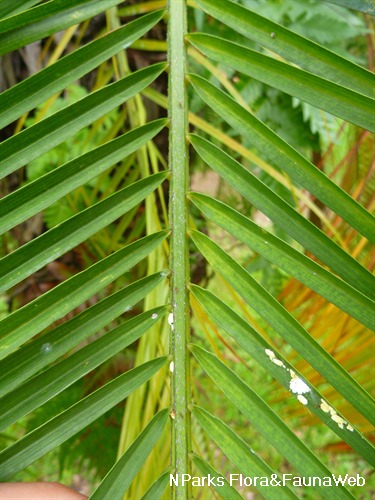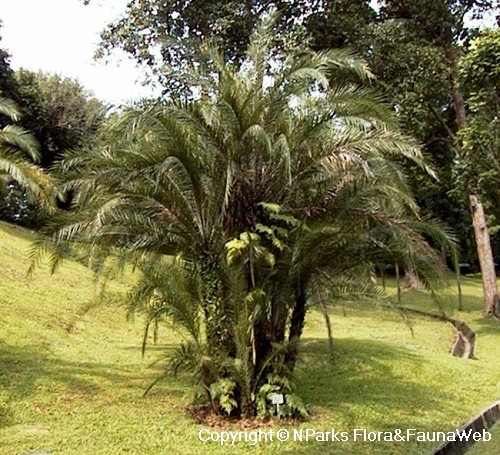
Back
Phoenix roebelenii O'Brien
| Family Name: | Arecaceae (Palmae) |
| Common Name: | Miniature Date Palm, Pygmy Date Palm, Roebelin Palm, Dwarf Date Palm, 江边刺葵 |
Name
Classifications and Characteristics
| Plant Division | Angiosperms (Flowering Seed Plants) (Monocotyledon) |
|---|---|
| Plant Growth Form | Palm (Solitary Habit, Clustered Habit) |
| Lifespan (in Singapore) | Perennial |
| Mode of Nutrition | Autotrophic |
| Maximum Height | 1 m to 3 m |
Biogeography
| Native Distribution | Laos, Myanmar, Thailand and Vietnam. |
|---|---|
| Native Habitat | Terrestrial (Primary Rainforest, Riverine) |
| Preferred Climate Zone | Tropical, Sub-Tropical / Monsoonal |
| Local Conservation Status | Non-native (Horticultural / Cultivated Only) |
Description and Ethnobotany
| Growth Form | A delightful, small to medium size, solitary, slow-growing, hardy palm that is topped with a dense crown of bright green, narrow, feathery fronds with neatly arranged leaflets along the upper portion of the gently recurved leaf stems, giving the palm a very graceful appearance. |
|---|---|
| Trunk | Trunk solitary (unlikely to be producing several though it can happen), slender, roughened by retaining old leaf bases, grey. |
| Foliage | Fronds pinnate (feather-like), about 0.6 to 1.2 m long, gently arching, narrow, bright green; leaflets around 100, arranged in a single plane on the upper portion of the leaf stem, about 15 to 25 cm long and 1 cm broad, slightly drooping, glaucous (covered or whitened with a very fine, powdery substance); petiole armed with sharp needle-like spines. |
| Others - Plant Morphology | Flower: Inflorescences multi-branched, tightly bunched, cream, about 30 to 45 cm long, emerging from among the fronds. Fruit: Fruits oblong, 1 to 1.2 cm long, black when ripen, akin to a small, thin-fleshed date. |
| Cultivation | Adaptable to a wide range of soils but prefers moist, well-draining soils with adequate and regular watering to give a healthy look. It can be grown under direct sunlight or partial shade and is drought tolerant once established. When planted indoors, it requires a high light intensity for the plant to sustain its health and light requirement. It reacts well to mild doses of nitrogenous fertilisers. Yellowing fronds from nutrient deficiencies will not recover thus, regular fertilisation is recommended to keep existing and new fronds green and vibrant. Caution: Petioles armed with needle-like spines that can injure, thus, handle with care. |
| Etymology | The genus epithet 'Phoenix' derives from the Greek name for the date palm, in reference to the fruits the genus produce. The species epithet 'roebelenii' is named after Carl Roebelen, the original collector who discovered the species in Laos. |
Plant Care and Propagation
| Light Preference | Semi-Shade, Full Sun |
|---|---|
| Water Preference | Moderate Water |
| Plant Growth Rate | Moderate |
Foliar
| Mature Foliage Colour(s) | Green |
|---|---|
| Foliar Shape(s) | Palm Fronds (Pinnate / Feather) |
| Leaf Area Index (LAI) for Green Plot Ratio | 2.5 (Palm - Solitary) |
Non - Foliar and Storage
| Trunk Type (Palm) | Solitary Habit, Aboveground |
|---|
Floral (Angiosperm)
| Flower Colour(s) | Cream / Off-White |
|---|
Fruit, Seed and Spore
| Mature Fruit Colour(s) | Black |
|---|
Image Repository
Others
| Master ID | 1372 |
|---|---|
| Species ID | 2665 |
| Flora Disclaimer | The information in this website has been compiled from reliable sources, such as reference works on medicinal plants. It is not a substitute for medical advice or treatment and NParks does not purport to provide any medical advice. Readers should always consult his/her physician before using or consuming a plant for medicinal purposes. |






